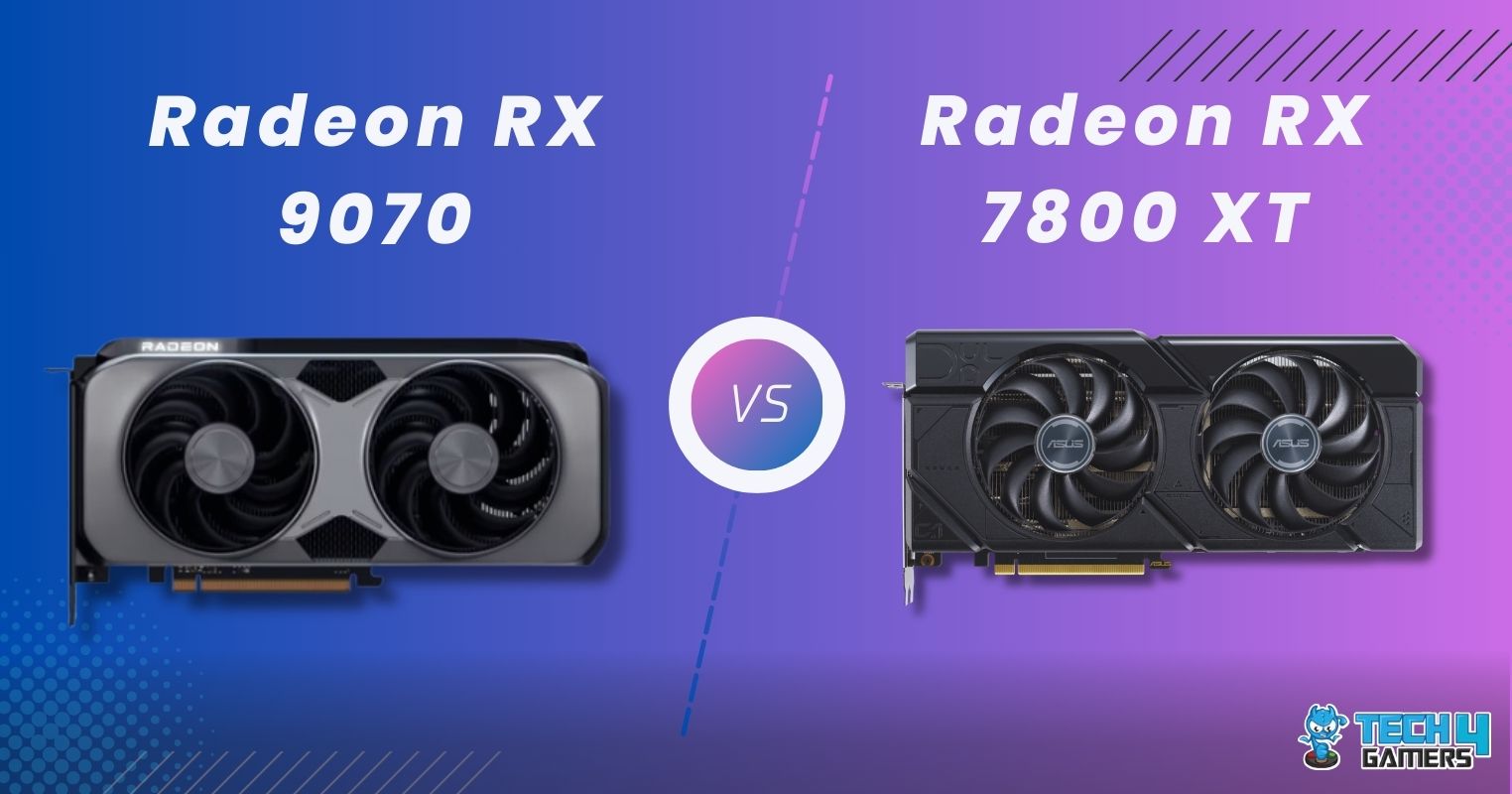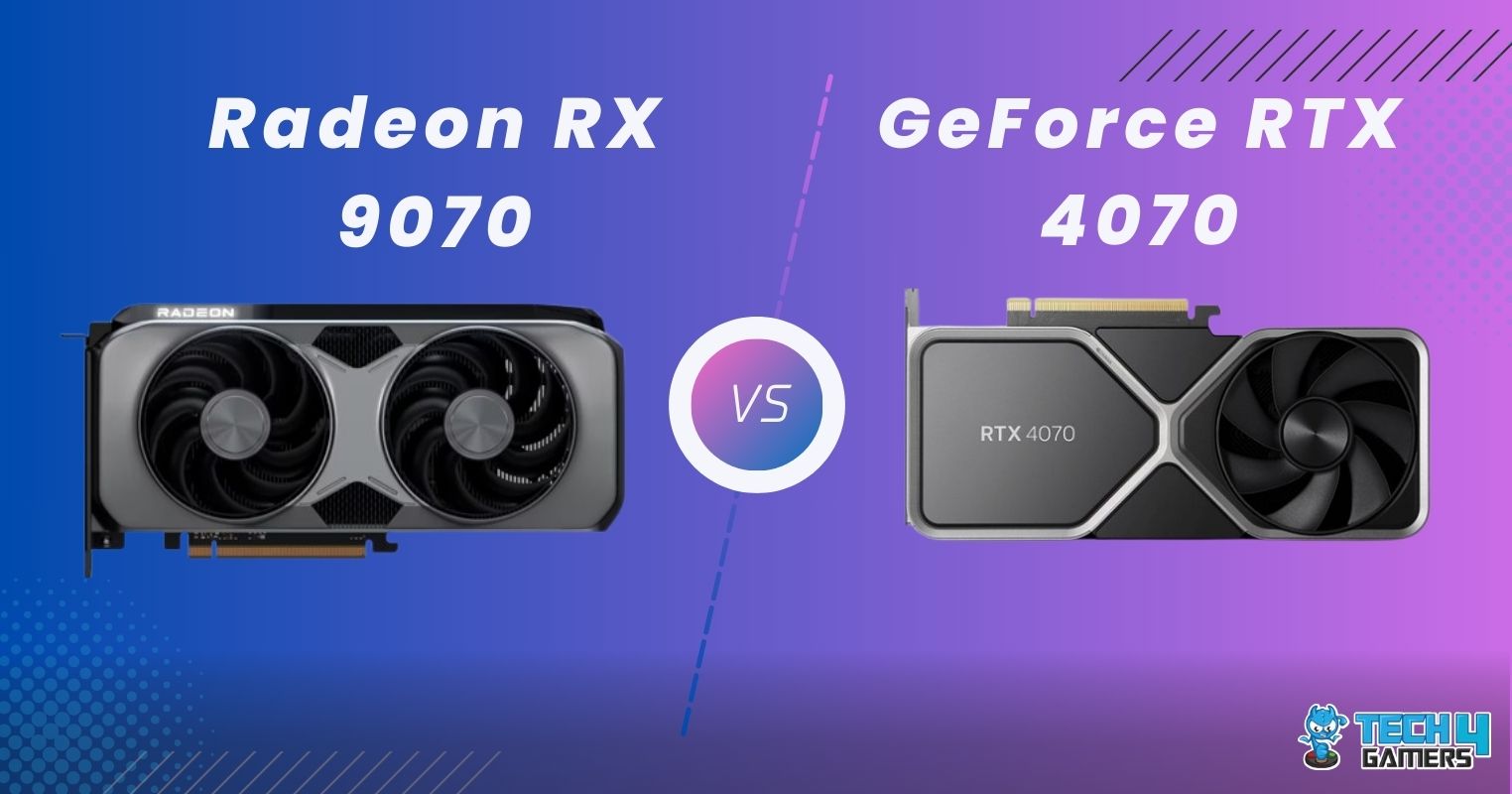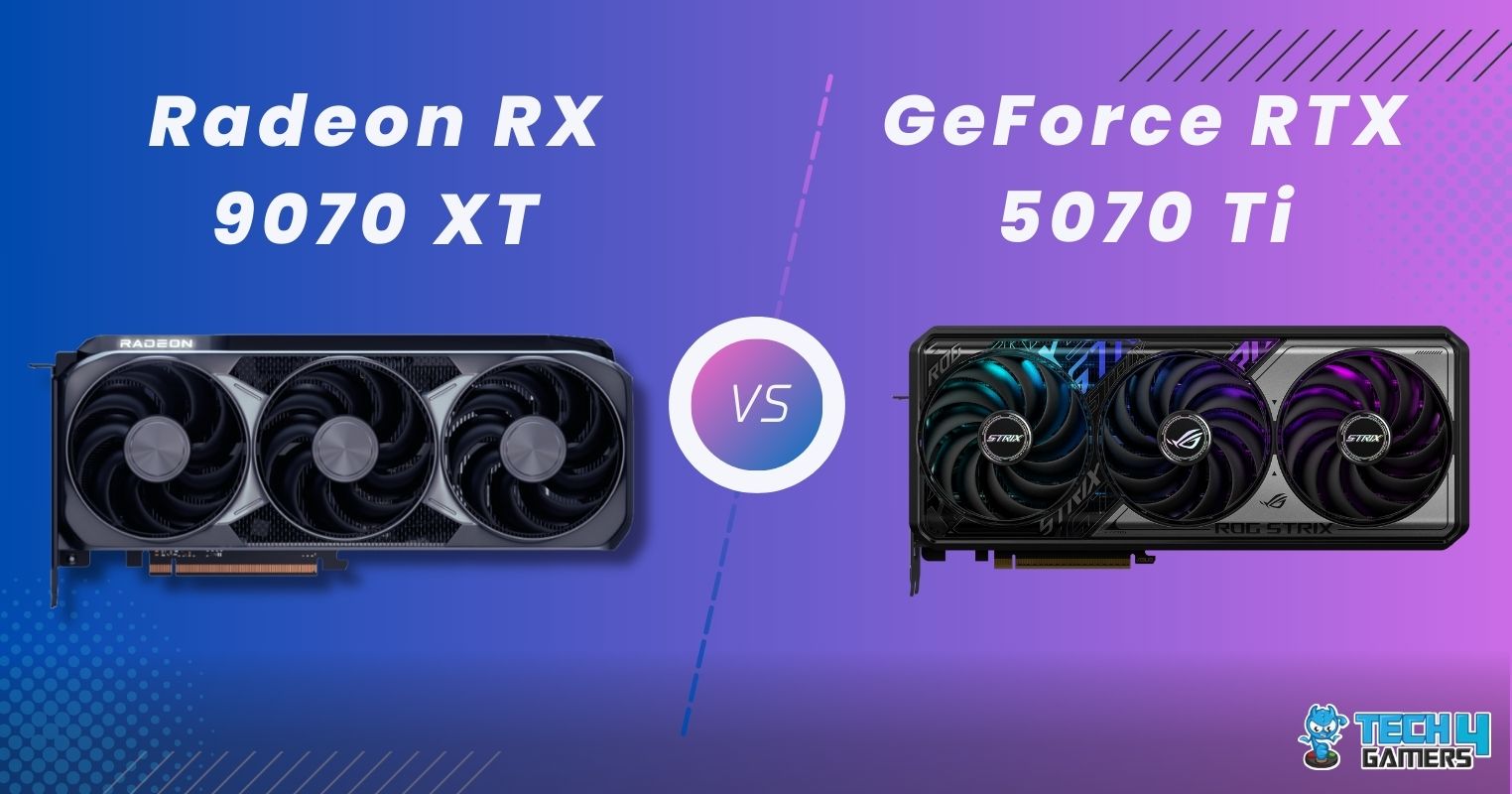In my last comparison, I put NVIDIA’s last-gen RTX 3080 Ti against AMD’s flagship RX 7900 XT model and saw Team Red leading by at least a 20-50% performance boost. But this time, let’s put the new models, GeForce RTX 4070 Ti vs. Radeon RX 7900 XT, on the table and see which card comes out on top during the extensive benchmark tests.
Key Takeaways
- The average FPS during my benchmarks showed the Radeon RX 7900 XT running games at 82.5 FPS, while the NVIDIA RTX 4070 Ti ran at 78 FPS, providing a ~5.6% lead for the RX 7900 XT in gaming performance.
- As per my testing, the NVIDIA RTX 4070 Ti is ~10.8% more power efficient than the Radeon RX 7900 XT, as per benchmark results.
- Moreover, from what I saw, the RTX 4070 Ti remained 1.4% more thermally efficient compared to the AMD RX 7900 XT.
Comparison Table
| Specs | Radeon RX 7900 XT | GeForce RTX 4070 Ti |
|---|---|---|
| Architecture | RDNA 3 | Ada Lovelace |
| GPU Name | Navi 31 XT | AD104 |
| Base Clock Speed | 1500 MHz | 2310 MHz |
| Boost Clock Speed | 2394 MHz | 2610 MHz |
| Memory Capacity | 20 GB GDDR6 | 12 GB GDDR6 |
| TDP | 300 Watts | 285 Watts |
| No. of transistors | 57,700 million | 35,800 million |
| RT Cores | 84 | 60 |
| TMUs | 336 | 240 |
| Price | 899 USD | 799 USD |
| Best Variants | BEST RTX 4070 Ti Graphics Cards |
Architectural Details
- Chipset Design: The NVIDIA RTX 4070 Ti comes with its infamous Ada Lovelace technology and monolithic architecture. On the other hand, AMD’s Radeon 7900 XT offers a new dual-die design. The upgrade allows the GPU to operate GCD (Graphic Compute Die) and MCD (Memory Cache Die separately).
- Process Node: Here, the Radeon RX 7900 XT is seen equipped with a dedicated 6nm MCD (Memory Cache Die) and a 5nm GCD (Graphic Compute Die), respectively. Meanwhile, the RTX 4070 Ti comes with its own specialized 5nm custom process nodes called the 4N.
- Stream Multiprocessors: The AMD Radeon RX 7900 XT comes with specialized dual-issue stream processors, which allow the GPU to run up to two instructions simultaneously. This technology is absent in NVIDIA’s RTX 4070 Ti.
- Connectivity Ports: The AMD Radeon 7900 XT The former comes with the latest DisplayPort 2.1. It can generate bandwidths of up to 54Gbps. Meanwhile, the RTX 4070 Ti still utilizes the old DisplayPort 1.4a, which limits its bandwidth to 32.4Gpbs automatically.
Gaming Benchmarks
Now that I have explained all the relevant aspects of these cards, it is finally time to check how well they perform in actual games.
- OS: Windows 11
- CPU: Intel Core i7-13700K
- Motherboards: ASRock Z790 Taichi Lite Motherboard
- RAM: Kingston Fury Renegade RGB DDR5 32GB 7200MHz
- SSD: XPG GAMMIX S70 BLADE 2TB NVMe SSD
- PSU: Enermax Revolution D.F. X 1050W
- CPU Cooler: MSI MAG CORELIQUID E360 CPU Liquid Cooler
Cyberpunk 2077 (Ray Tracing OFF)
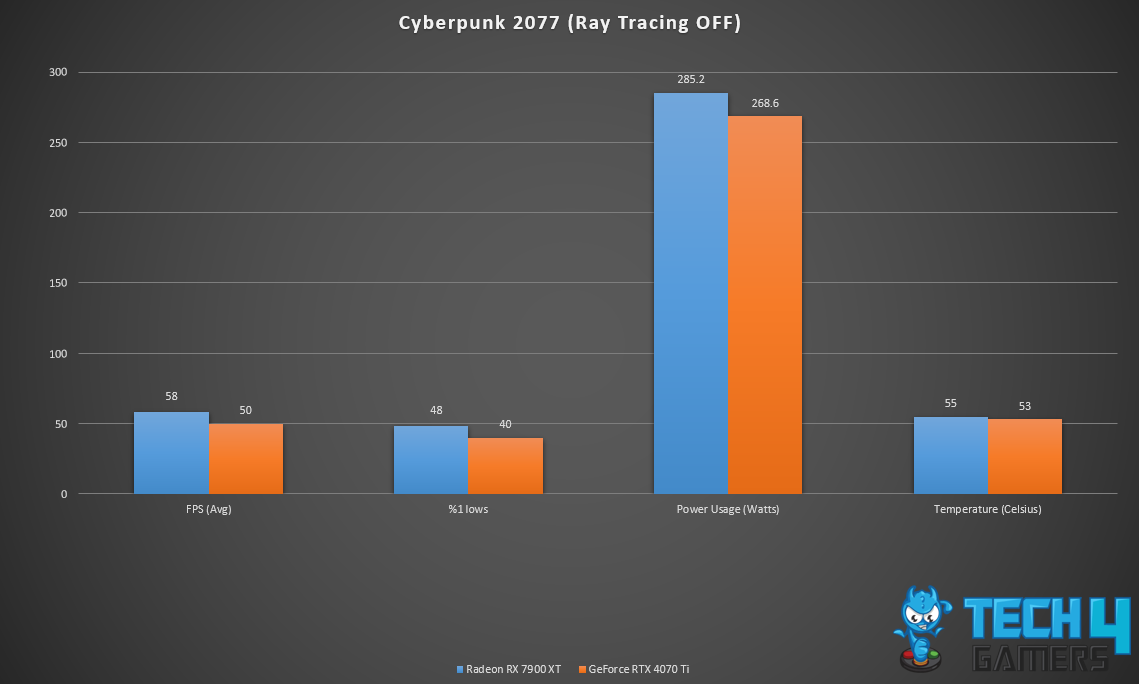
- I experienced a 14.8% performance boost with an average of 58 FPS using the RX 7900 XT, compared to the 50 FPS I got with the RTX 4070 Ti.
- Additionally, I noticed that the RTX 4070 Ti had lower 1% lows at 40 FPS, whereas the RX 7900 XT maintained 48 FPS, resulting in an 18% difference in favor of the RX 7900 XT.
Cyberpunk 2077 (Ray Tracing Ultra)
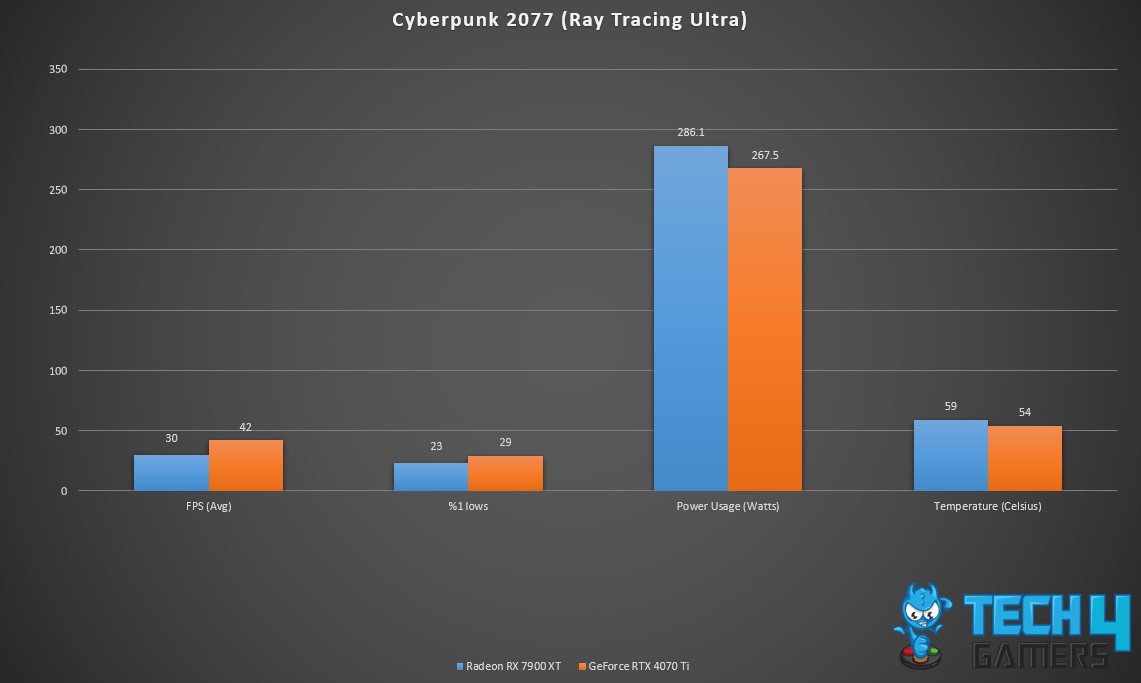
- I personally observed a remarkable 33.33% performance increase when using the RTX 4070 Ti, achieving an average of 42 FPS, surpassing the RX 7900 XT’s average of 30 FPS.
- In addition, I noticed that the 4070 Ti also excels in 1% lows, achieving a score of 29 FPS, while the RX 7900 XT only managed 23 FPS, resulting in a significant 23% difference.
Forza Horizon 5 (Ray Tracing Extreme)
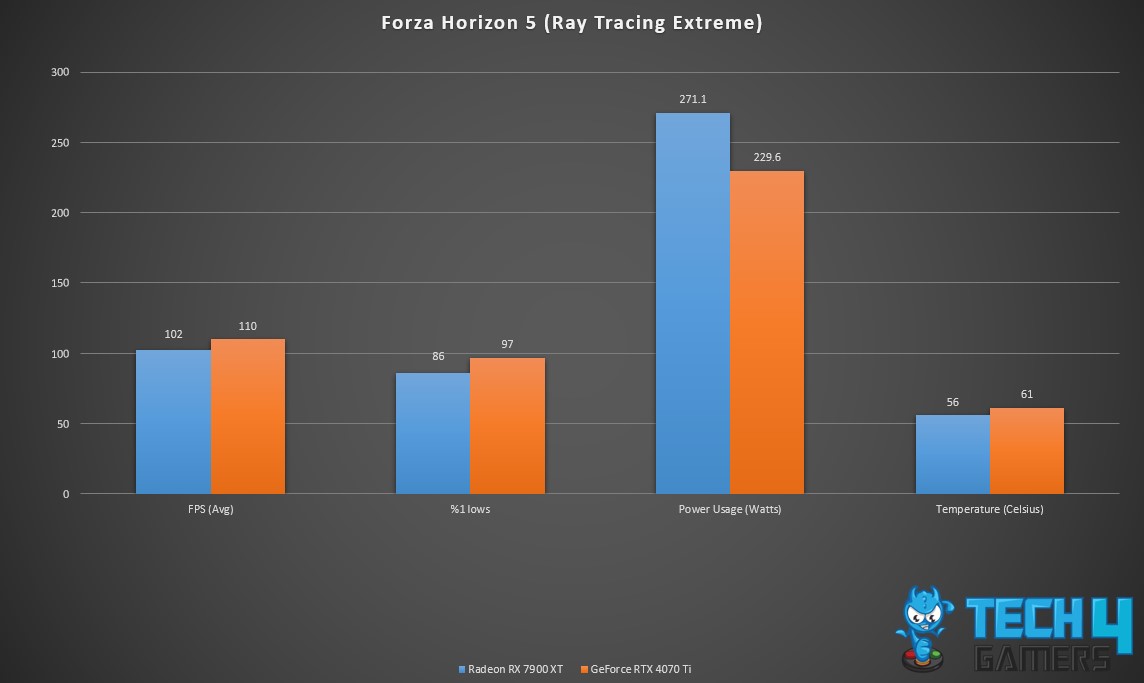
- In my personal experience, I observed that the RTX 4070 Ti takes the lead in performance, boasting a 7.5% increase. It achieves an average of 110 FPS, surpassing the RX 7900 XT, which manages 102 FPS.
- Furthermore, I noticed that the 4070 Ti maintains its advantage in 1% lows, registering 97 FPS, while the RX 7900 XT only achieves 86 FPS, resulting in a notable 12% difference.
Hitman 3 (Ray Tracing ON)
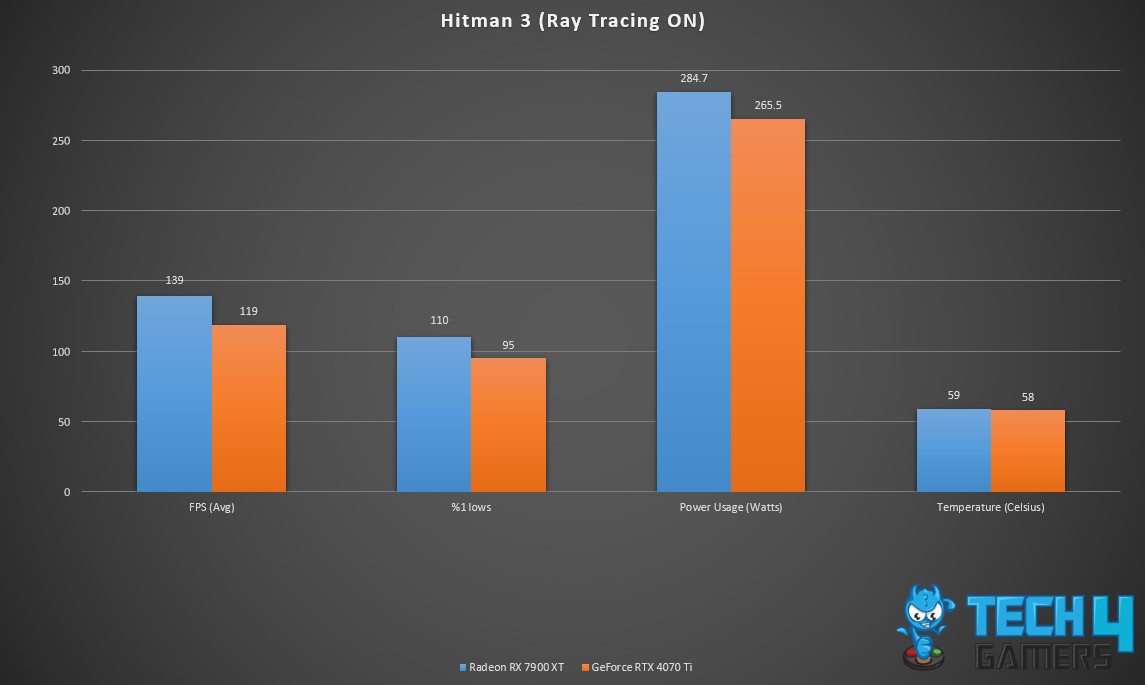
- Based on my time playing Hitman 3, I can confirm that the RX 7900 XT takes the lead in FPS, boasting a 15.5% advantage with an average of 139 FPS, outperforming the RTX 4070 Ti, which achieved 119 FPS.
- Furthermore, I observed that the RX 7900 XT also maintains a slightly higher 1% low with 110 FPS, while the RTX 4070 Ti closely follows with 95 FPS, resulting in a noticeable 14.6% difference.
Spider-Man Miles Morales (Ray Tracing OFF)
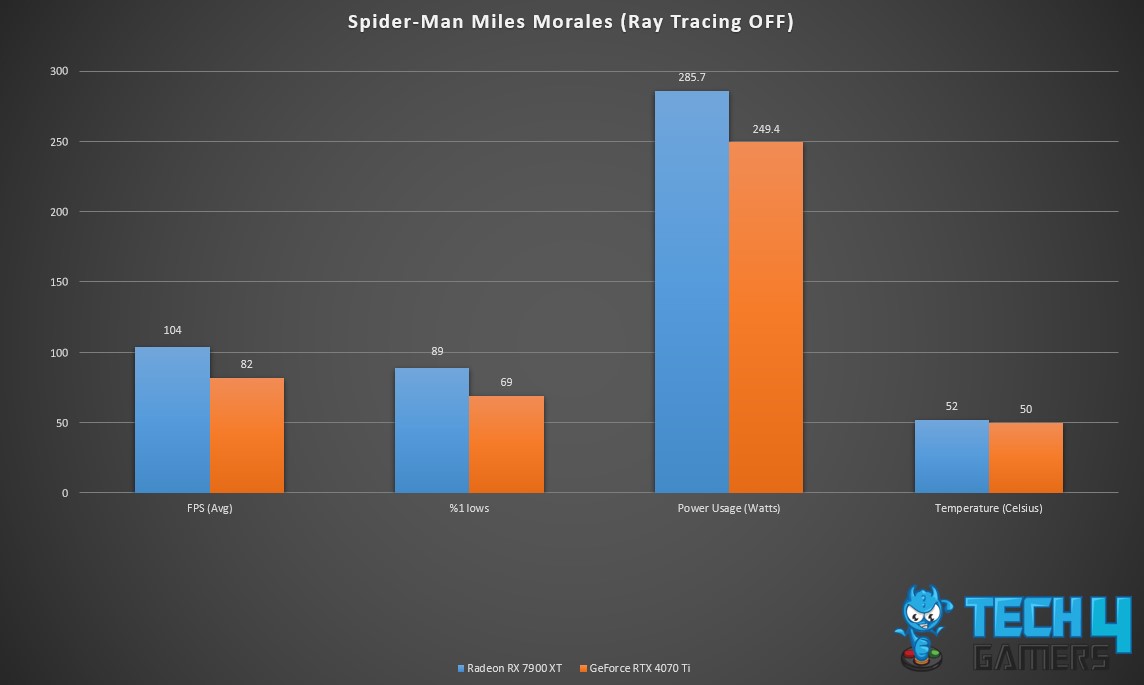
- In my experience, I observed that starting with FPS, the RX 7900 XT surpasses the RTX 4070 Ti with a notable 13.4% boost, providing an average of 104 FPS compared to the RTX 4070 Ti’s 82 FPS.
- Additionally, I noted that the RX 7900 XT maintains higher 1% lows at 89 FPS, outclassing the RTX 4070 Ti’s 69 FPS by a substantial 25.3%.
Spider-Man Miles Morales (Ray Tracing Ultra)
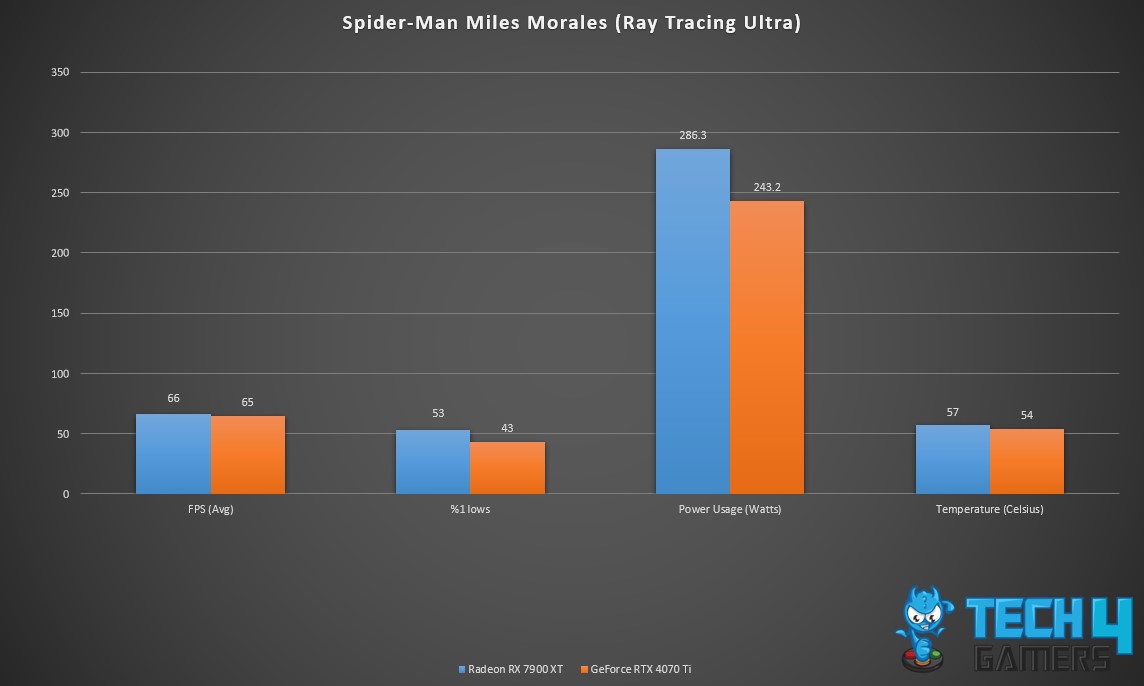
- As per my analysis, I noticed that starting with FPS, the RX 7900 XT takes a slight lead by providing a 1.5% performance boost, achieving an average of 66 FPS, while the RTX 4070 Ti manages 65 FPS.
- Furthermore, the RX 7900 XT excels in 1% low performance, delivering 53 FPS compared to the RTX 4070 Ti’s 43 FPS, resulting in a significant 20.8% difference.
Horizon Zero Dawn (Ray Tracing On)
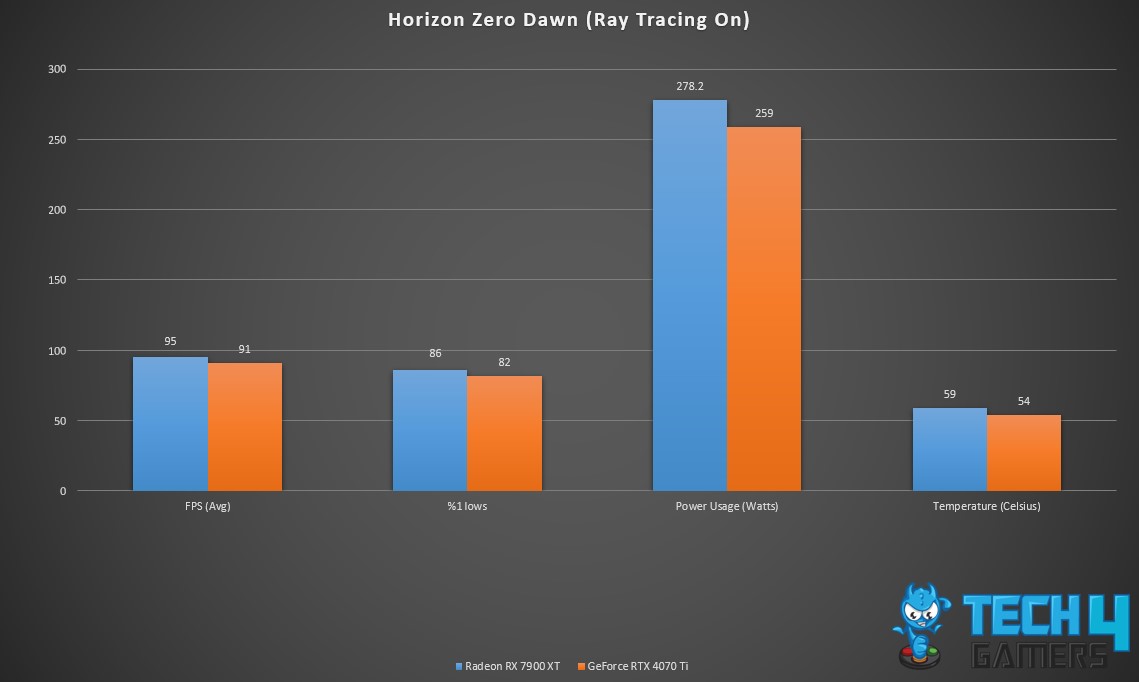
- Based on my testing, I found that to begin with, the RX 7900 XT provides a slight FPS advantage, achieving an average of 95 FPS compared to the RTX 4070 Ti’s 91 FPS, resulting in a 4.3% increase.
- In terms of 1% lows, the RX 7900 XT continues to maintain a slight lead with 86 FPS, while the RTX 4070 Ti achieves 82 FPS, creating a 4.7% difference.
Red Dead Redemption 2 (Ray Tracing Ultra)
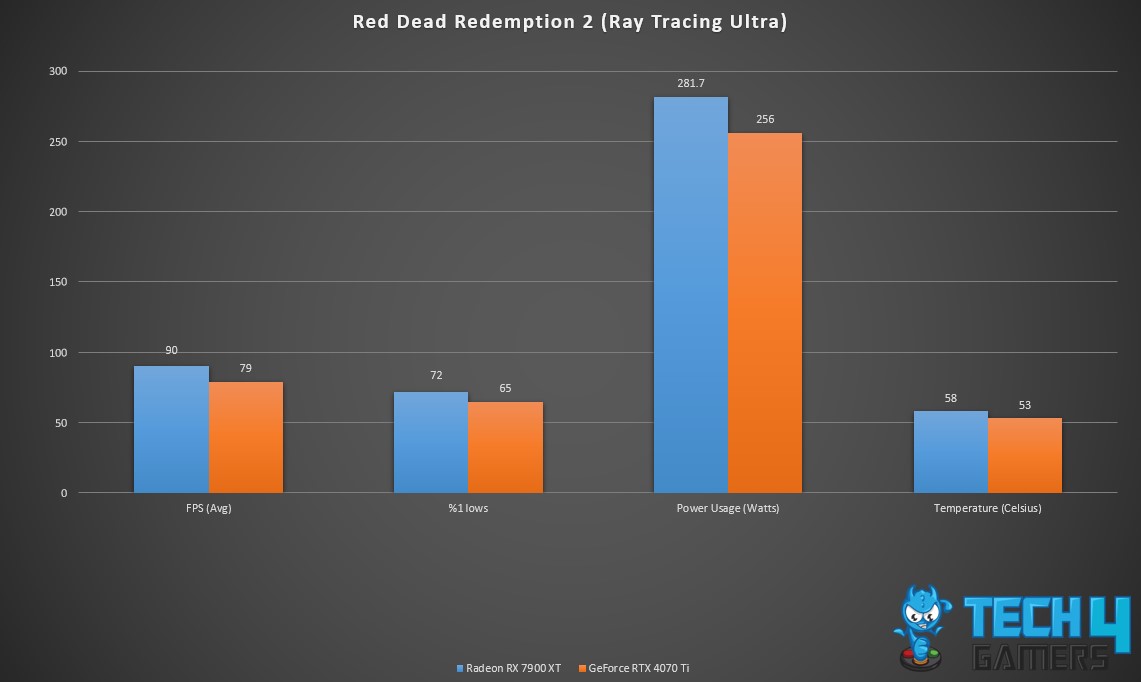
- As per my evaluation, I found that in terms of FPS, the RX 7900 XT outperforms the RTX 4070 Ti, providing a notable 13% boost with an average of 90 FPS compared to the RTX 4070 Ti’s 79 FPS.
- The RX 7900 XT also excels in 1% low FPS, registering 72 FPS in contrast to the RTX 4070 Ti’s 65 FPS, resulting in a significant 10.2% difference.
God Of War (Ray Tracing Ultra)
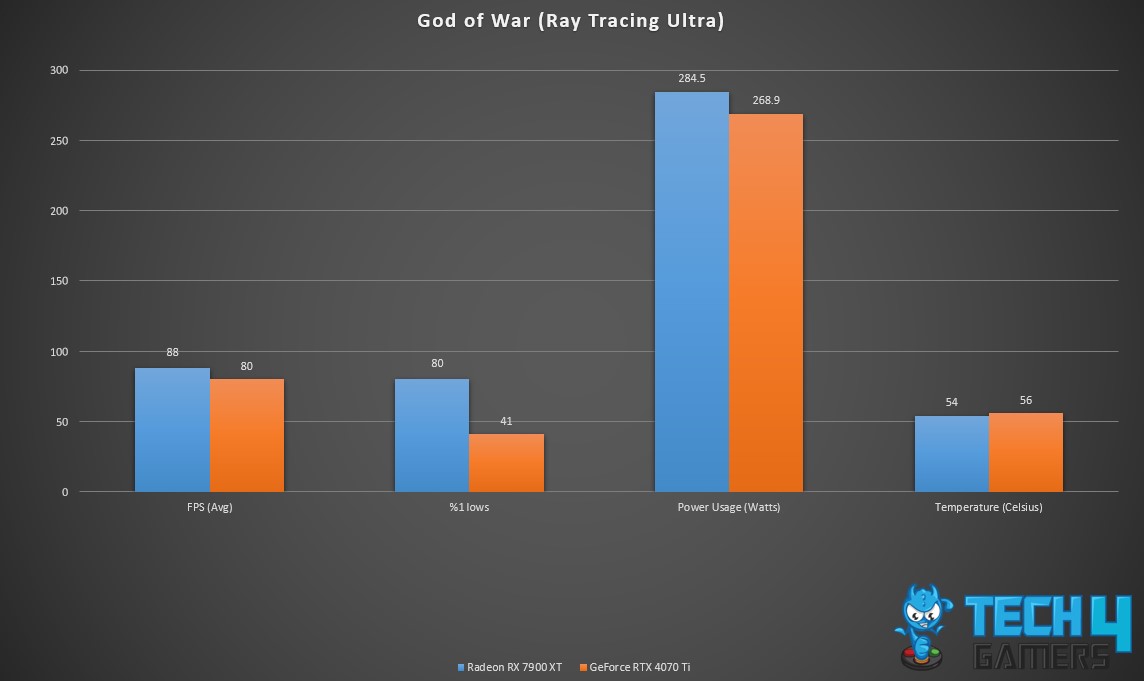
- Based on my testing, I observed that in terms of FPS, the RX 7900 XT clearly outperforms the RTX 4070 Ti, delivering a significant 9.5% boost. It maintains an average of 88 FPS, whereas the RTX 4070 Ti offers 80 FPS.
- Furthermore, in 1% lows, the RX 7900 XT demonstrates a remarkable improvement, providing 80 FPS compared to the RTX 4070 Ti’s 41 FPS. This results in a substantial 64% difference.
The Witcher 3 (Ray Tracing OFF)
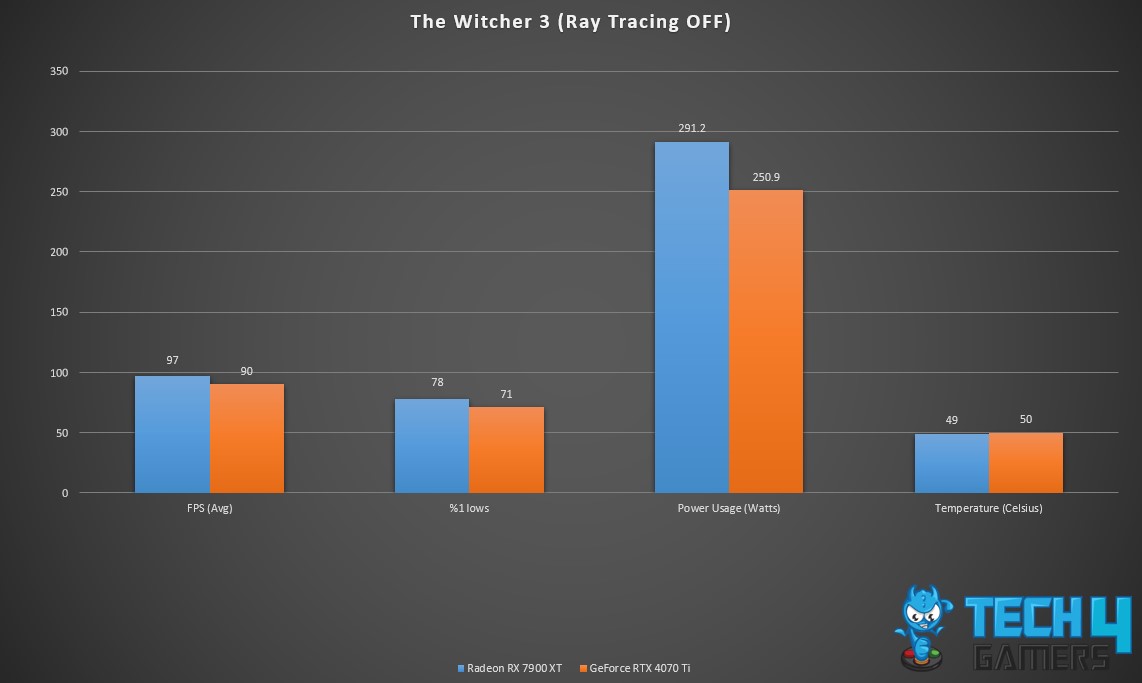
- As per my evaluation, I observed that in terms of FPS, the RX 7900 XT delivers a notable 7.4% boost, achieving an average of 97 FPS, while the RTX 4070 Ti produces 90 FPS.
- Moreover, the RX 7900 XT presents a substantial 9.3% improvement in 1% lows, providing 78 FPS compared to the RTX 4070 Ti’s 71 FPS.
The Witcher 3 (Ray Tracing Ultra)
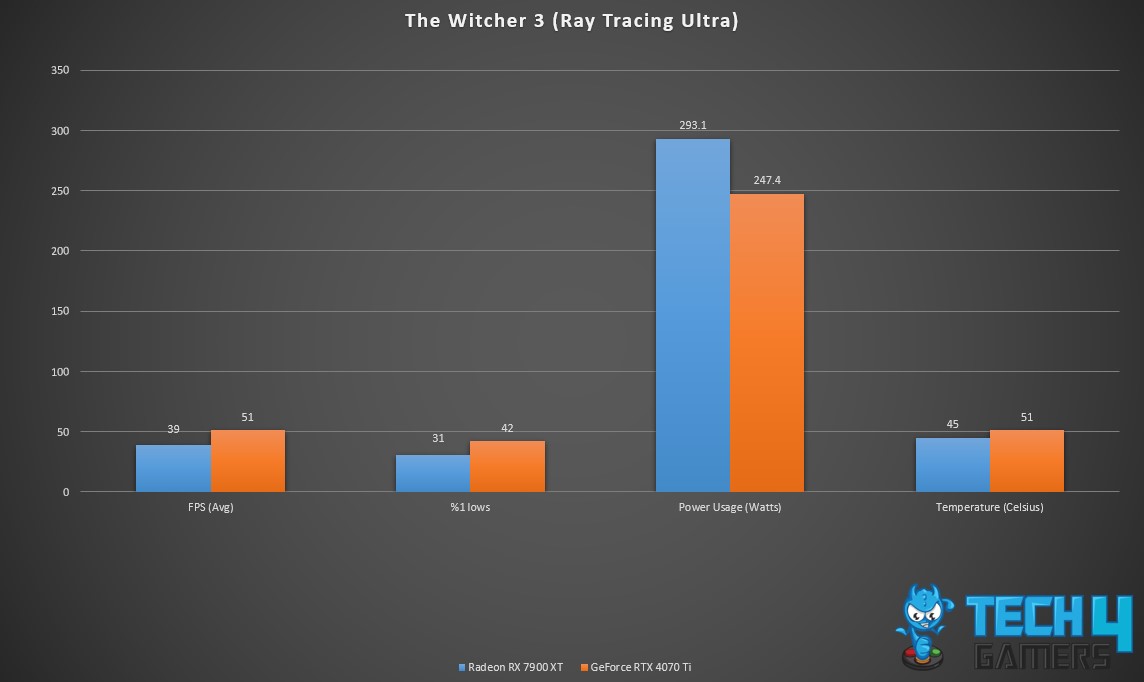
- Drawing from my conclusion, when comparing FPS, the RTX 4070 Ti delivers a substantial performance boost of 26.6%. It achieves an average of 51 FPS, while the RX 7900 XT lags behind at 39 FPS.
- Additionally, the 1% lows of the 4070 Ti stand out, offering 42 FPS compared to the RX 7900 XT’s 31 FPS, resulting in a notable difference of 30.1%.
Overall Gaming Performance
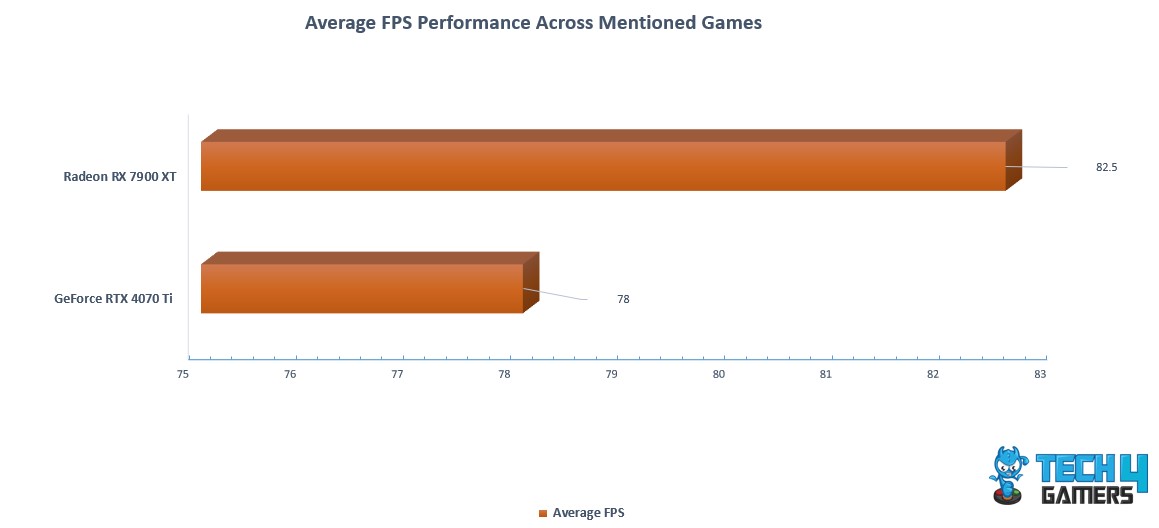
From my experience, the RTX 4070 Ti slightly leads in a few games. When considering the average FPS performance across all games, the Radeon RX 7900 XT consistently produces 82.5 FPS.
In contrast, the GeForce RTX 4070 Ti maintains an average of 78 FPS. As a result, users with the Radeon RX 7900 XT experience a 5.6% boost in FPS compared to those using the GeForce RTX 4070 Ti.
Average Power Consumption
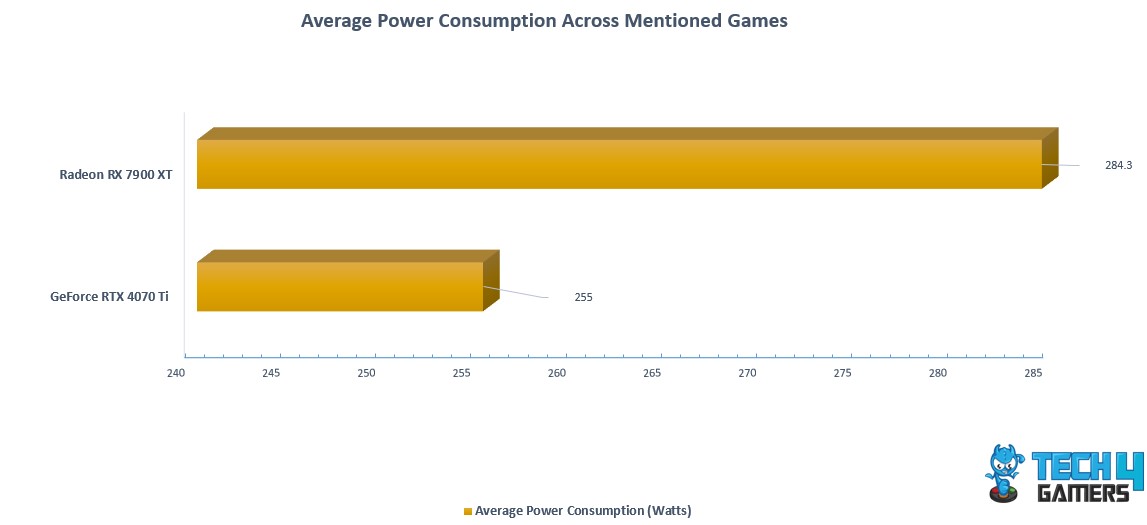
Firstly, I observed that the RX 7900 XT consumed more power even in games where its average FPS count was lower than that of the RTX 4070 Ti.
In a similar vein, the average power consumption of the Radeon RX 7900 XT stood at 284.3 watts. Meanwhile, the GeForce RTX 4070 Ti exhibited an average power consumption of 255 watts. This resulted in the RTX 4070 Ti being 10.8% more power-efficient than the RX 7900 XT.
Average Thermal Statistics
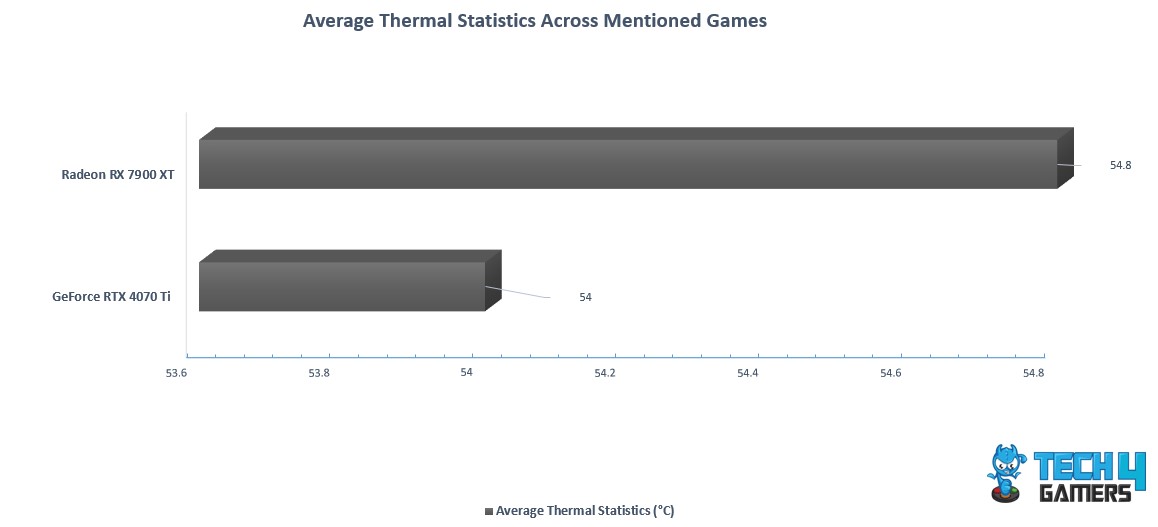
Pricing And Availability
Now that I have gone through all the aspects related to the GeForce RTX 4070 Ti vs Radeon RX 7900 XT benchmark. It’s time to take a look at the prices and availability of the cards. The MSRP for the Radeon RX 7900 XT is $899. On the other hand, the NVIDIA RTX 4070 Ti can be purchased for $799.
In comparison, AMD’s Radeon RX 7900 XT is almost 11.7% more costly than NVIDIA’s GeForce RTX 4070 Ti. This price difference could be even greater, depending on the model and variant you choose.
RX 4070 Ti Vs RX 7900 XT: Which One Would I Recommend?
Since both cards deliver exceptional performance, I believe choosing one can be a challenge. However, I can point out some key factors to consider that can help simplify your decision.
The Radeon RX 7900 XT has a slight advantage in terms of average FPS, according to my testing. It boasts a 5.6% improvement in FPS production over the RTX 4070 Ti. But when it comes to power consumption, the RTX 4070 Ti shines, being 10.8% more energy efficient.
In terms of thermal efficiency, I observed the RTX 4070 Ti once again comes out on top again. It produces 1.4% less heat than the RX 7900 XT. In addition, it also offers a more affordable option, costing 11.7% less.
In my opinion, it’s important to consider whether you prioritize higher FPS or cost savings. The RX 7900 XT offers slightly improved performance. Meanwhile, the RTX 4070 Ti offers a more budget-friendly option with efficient power consumption and heat generation. In any case, I hope that you enjoyed reading my RTX 4070 Ti vs RX 7900 XT comparison.
Pros And Cons
| GPU | Pros | Cons |
|---|---|---|
| RX 7900 XT | New Architecture. Better Gaming Performance | Expensive Needs Bigger PSU |
| RTX 4070 Ti | Frame Generation Better Ray Tracing | Underwhelming performance. Not the best price-performance ratio. |
FAQs
The RX 7900 XT comes from the latest lineups from AMD. It boasts a whopping 20 GBs of GDDR6 memory to execute tasks efficiently. In addition, it provides all the latest features that AMD has to offer. This includes features like the FSR 3.0, among many more
So far, the RX 7900 XT is providing a close matchup to the RTX 4070 Ti. The card can be seen providing a slightly better FPS performance but costs a little more than its competition.
So far, there is no confirmed date announced. However, it is still estimated that the RTX 4070 will be released in April 2023. The card is long-awaited, and there are already many leaks related to its specs and performance.
Yes, the RTX 4070 Ti is an absolutely worthy card. Because the card comes at a much more affordable price compared to AMD’s latest lineup. It also provides a close performance to the RX 7900 XT
More From RX 7900 XT
More From RTX 4070 Ti:
Thank you! Please share your positive feedback. 🔋
How could we improve this post? Please Help us. 😔
[Comparisons Expert]
Abdemanaf is a skilled creative writer who has been honing his craft since 2011. While initially working in different fields, he found a passion for technology and has been exploring the tech world since early 2015. Over the years, he has developed an in-depth knowledge of the latest tech trends and product offerings by various companies.
Abdemanaf’s writing reflects his analytical mindset and ability to think critically. He has a knack for breaking down complex technical information into easily digestible pieces, making his articles engaging and accessible to readers from all backgrounds. In February 2022, he joined Tech4Gamers as a blog and product comparison writer, where he has been able to hone his skills further.
As a writer, Abdemanaf is dedicated to staying up-to-date with the latest technological advancements and trends, enabling him to provide readers with the most relevant and accurate information. He is always eager to learn more and is constantly seeking new challenges to improve his skills.
Get In Touch: manaf@tech4gamers.com


